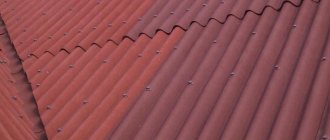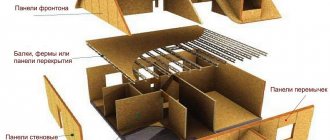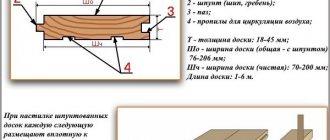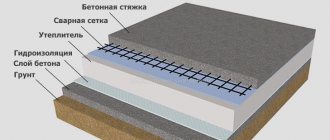Serial connection
It is quite easy to implement such a scheme for installing ceiling lamps with your own hands, since it does not require a large number of wires. However, no more than six lamps can be connected in series, and the lighting will not be as effective. In addition, with a serial connection, a malfunction of one light source breaks the circuit, therefore, the operation of all lamps stops. To restore the functionality of the circuit, it is necessary to check each light bulb.
The connection diagram is as follows: the phase sequentially bypasses all lighting devices, and zero is applied to the output of the last lamp.
When deciding how to connect LED ceiling lights, special care and attention should be exercised. It is very important that the phase goes exactly to the switch and then to the lamps. Zero should go to the last element of the electrical circuit. This scheme will make the operation of the lamps safe and reliable.
When connecting to three-wire wiring that has an additional ground wire, the third wire must be connected to the appropriate terminal of each lamp. In this case, the grounding wire can come from the “ground” block, from the nearest outlet or switch.
A similar circuit for connecting spotlights is used very rarely, since the phase constantly breaks on the lamps. At the same time, the neutral wire remains intact all the way from the junction box to the output of the last lighting device in the chain.
Which light bulb will shine brighter and why?
A lamp whose filament has greater resistance will burn better and brighter.
Take for example light bulbs that are radically different in power - 25W and 200W - and connect them in series.
Which one will glow at almost full intensity? The one with P=25W.
The resistivity of its tungsten filament is significantly greater than that of two hundred, and therefore the voltage drop across it is comparable to the voltage in the network. With a series connection, the current will be the same in any part of the circuit.
At the same time, the amount of current that can ignite 25 watts is in no way capable of “setting fire” to two hundred. Roughly speaking, a light source with a lamp of 200W or more will be perceived relative to 25W as an ordinary section of wire through which current flows.
You can increase the number of lamps and add one more to the circuit. This is done again very simply.
Twist the two ends of the power wire of the third lamp with any ends from the first two. And to the remaining ones you again supply 220V.
1 of 2
How will this garland glow in this case? The voltage drop will be even greater, which means the light bulbs will not only light up at half power, but will barely burn at all.
Parallel connection - diagram
Lighting devices with parallel connections shine with the same intensity, but installation involves the use of more wires. Despite this, installation of spotlights with parallel connection is popular. This method allows you to install an unlimited number of lighting devices, including LED lamps, the main thing is to use a non-flammable VVG ng cable. The shape of the cable can be round or flat, but it must be non-flammable. This especially applies to installing lamps on wooden ceilings.
Parallel connection is carried out in two ways:
- Beam connection.
- Daisy chain connection.
In the first case, solving the question of how to connect lamps on the ceiling involves connecting each point lighting device to its own piece of wire. Using this option requires a lot of cable consumption, however, if one lamp fails, the entire circuit works without interruption. The cable routing along the ceiling should look like this: a cable is pulled from the junction box to the center of the room and fixed in this place. Wires go to the lamps from one central point. The presence of a large number of wires converging in one place requires reliable fixation. Single-core wires can be twisted, and the twisted area can be crimped with pliers and soldered.
The mounting of ceiling lamps is strong, reliable, but not detachable. A simpler method involves using connectors with a certain number of inputs to which wires are connected. In addition, there are special devices - terminal blocks, they are more expensive, but the wires in this case, the problem of how to connect spots on the ceiling is solved quickly, easily and firmly. You can use terminal blocks with screw connections; they also provide a reliable connection, but in order to supply voltage to all wires, additional jumpers must be installed on the terminals involved.
In the second case, two wires are alternately fed and exited to each lamp. The connection diagram for spotlights on the ceiling is as follows: a cable goes from the distribution box to the first lighting device. A second cable is connected to the output of the same device and stretched to the next lamp. Similar actions are performed with other devices.
If desired, you can divide the lighting fixtures on the ceiling into two groups; in this case, you must connect to a switch with two keys. The complexity of such a scheme lies in the use of more wires.
Application of both schemes in everyday life
The most popular products with a serial connection are garlands.
This model can be used for other purposes:
- make cheap lighting in a long corridor;
- save on the purchase of light bulbs due to frequent burnout by connecting additional ones;
- extend the life of light sources (if instead of one 60 W, connect 2 100 W).
Reference! Experienced electricians use this property to determine the phases in a three-phase network.
In workshops and garages, powerful incandescent or halogen lamps are used for heating. Two 1 kW elements are connected in series and placed in a metal container, which is installed on a brick. The temperature of such a heater is approximately 60°C. But you should take into account the minus - the lamps burn out very quickly.
The parallel circuit is used in premises for any purpose (in lighting, chandeliers), and on the streets. It allows you to turn on individual light sources regardless of the operation of the others, just connect several switches. Usually, not only lamps, but also all electrical appliances in residential buildings are connected in parallel and connected to a 220 V household network.
A mixed model is often used to connect LED lamps. Several serial chains are created, which are connected to each other in parallel.
How to connect 12 Volt lighting devices
When deciding how to connect ceiling lamps, similar circuits are used, the difference is as follows: the cable from the junction box goes to the switch, then goes to the converter, and from its output it is supplied to the lamps.
When installing a large number of spotlights, it is recommended to divide them into two groups and connect them to a switch with two keys. Since the result is two branches, it is necessary to take two devices to reduce the voltage. You can use switches with three keys or install several single-key devices. Lighting over a wide range is provided using a dimmer.
A distinctive feature of the listed schemes is the presence or absence of an adapter. Otherwise, the solution to the question of how to make a spot light on the ceiling is no different.
How to phasing inputs with incandescent light bulbs
Let's say you need to connect two three-phase (380V) inputs in parallel with each other, from the same power source. You don’t have a voltmeter, multimeter or tester at hand. What to do?
After all, if you mix up the phases, you can easily create a phase-to-phase short circuit! And here again, a sequential assembly of just two light bulbs will help you.
Assemble them according to the very first diagram given and connect one end of the power wire to input phase No. 1, and with the other end touch the wires of input No. 2 one by one.
With phases of the same name, the lamps will not light up (for example, fA input No. 1 - fA input No. 2).
And if they are different (fA input No. 1 - fV input No. 2) - they will light up.
You would never succeed in such an experiment with only one lamp, since it would instantly explode from the increased voltage for it of 380V. And in a series assembly with two products of the same power, the voltage will be applied to them within normal limits.
But the best and most practical application is to use this circuit not for lighting at all, but for heating. That is, your light sources will primarily work not as lamps, but as heaters.
How to make such a simple and uncomplicated infrared stove, read the article at the link below.
Something similar is often used in incubators.
How to choose the right transformer power
Before connecting ceiling lamps, one point should be understood: for normal operation of all connected lighting fixtures, it is necessary to use a transformer whose power is 20% higher than the total power of the lamps in the electrical circuit. For example, a power reduction device is required for 8 40-watt light bulbs. First, the total power is determined: 8*40=320 Watts. Therefore, for this voltage you should purchase a driver with a power of about 400 Watts.
When calculating voltage, it is important to take into account that a large number of light bulbs requires a higher power converter. However, the cost and size of the step-down device increases with increasing power value. To solve the problem, spotlights are divided into several groups and a transformer is connected to each of them. But in this case, the converters must have less power.
Laws of series and parallel connection of conductors
For a series connection, it is important to consider that the same current flows through all lamps. This means that the more elements there are in a circuit, the fewer amperes flow through it. The voltage across each lamp is equal to the product of the current and its resistance (Ohm's law). By increasing the number of elements, you will lower the voltage on each of them.
In a parallel circuit, each branch takes on the amount of current it needs, and the voltage is applied that is supplied by the power source (for example, a household electrical network)
Stretch ceiling
Spotlights are in most cases used to illuminate suspended and suspended ceiling structures. When installing a stretch ceiling, first lay the wires and fix them on the base ceiling, without connecting to power. After this, special suspensions are installed and lighting devices are fixed in them. Now you can connect the electrical cable and check the lighting operation.
Before directly tensioning the canvas, turn off the power supply, remove light sources and those parts that cannot withstand strong heat. After the canvas is stretched, holes are cut in it at the location of the spotlights, the slots are secured with O-rings and the light sources are assembled.
Connection to 220 Volt voltage
As mentioned above, to supply power to 12-volt spotlights, additional equipment, a converter, transformer or driver is required. However, recently a new product has appeared on the lighting market - spots operating on 220 Volts. In this regard, it became necessary to study in more detail the scheme for connecting and installing spots directly to a 220 Volt network, without using transformers.
Read also: How to charge an alkaline battery at home
How to wire
The laying of wires is carried out at the stage of forming the base of the ceiling. They are secured so that there is no tension or excessive sagging. To install the wiring yourself, you need to adhere to the following algorithm:
- A distribution box needs to be installed. It should not be located behind the ceiling trim. There must be access to it.
- A corrugated cable line is laid from the box to all installation locations of the lighting device.
- If halogen devices are used, all transformers are connected with a separate wire. In the electrical circuit, halogen bulbs should be connected in parallel to each other, and the switch should go to the transformer on the 220V side. To connect the wires in the transformer, terminals N and L are provided.
- After fixing the wires, the lamps begin to be installed.
Wiring
How to install spots
To know how to connect spots, you need to familiarize yourself with the general recommendations. On the ceiling or wall, use a mounting strip fixed on the inside of the base of the spot.
You may be interested in this Features of the electrician program
Unscrew 2 screws from the sides of the case and remove this strip. Then you need to fix it to the wall using 2 screws. The bar is placed directly next to the power cable so that the screws do not damage it during fixation. When the installation process of the spot is completed, it is possible to begin connecting it.
Installation of spots
Safety precautions
Installation of lamps requires strict implementation of instructions and adherence to safety rules. Before connecting lighting devices, it is necessary to turn off the power supply. Then, using a tester, you need to make sure that the electrical network is not working. Before installation begins, it is necessary to decide on the location where the devices will be placed.
To ensure eye safety, the installation of lamps is carried out using special glasses that protect the eyes from the penetration of construction dust and other fragments.
Connection features
Self-installation of spotlights, contrary to popular belief, is not a difficult electrical installation process. It will take a small amount of time and will not require any special skills.
How to connect
When a suspended ceiling is installed, holes for lamps are cut out on it. Before cutting them out, you need to take into account the location of the device at a specific depth, taking into account the seams.
Holes for lighting fixtures on the ceiling are drilled using special wood bits or a drill with a cutter. In addition, these tools are used to install the socket box into the wall. When the fixture is square in shape, it is possible to use an electric jigsaw. The diameter of the hole is made 0.3-0.4 cm smaller than the outer diameter of the front part of the lamp. On suspended ceilings, experts install thermal rings under the lamps so that the coating does not deteriorate due to overheating. To create a hole for spotlights, you need:
- use only tools intended for these purposes;
- Before starting work, mark the holes and diameter;
- do not fix the plasterboard slabs until each hole has been drilled;
- In order not to drill a hole near the frame element (the device sometimes does not fit into the depth of the ceiling), it is recommended to use a magnet to locate it.
It is necessary to bring the wire out through the drilled hole and connect it to the terminal block when there are no clamps on the base. For all lamps, 2 wires of 11 cm in length are used. To connect, they are exposed (1-1.5 cm). One end is connected to the terminal and the other to the cable.
After connection, lamps are inserted into the holes made in the ceiling, clamping the spring antennae present in all structures. They diverge in the hole, the light element is fixed. All that remains is to screw in the light bulb and put on the cover. Self-installation of lamps will be completed.
Installation of the lamp
Mixed compound
Another name for this circuit is a series-parallel circuit. In the branches of a parallel circuit, several consumers are connected in series, for example, incandescent, halogen or LED. This scheme is often used on LED matrices. This method offers some advantages:
- connecting separate groups of light bulbs on a chandelier (for example, 6-arm);
- if a lamp burns out, only one group will not light, only one series circuit will fail, the rest, standing in parallel, will shine;
- group lamps in series of the same power, and parallel circuits of different power, if necessary.
Device design and varieties
The main area of application for spotlights is suspended and surface-mounted systems, including plasterboards, in which a certain distance is provided between the sub-ceiling and the new structure. This empty cavity is used to house the back of devices, wires, and other electrical items. Lamps can be attached to the ceiling and walls. They are often used to decorate cabinets and illuminate opening doors.
Any spotlight consists of several basic elements:
- the body of the device with legs supplemented with springs and used to secure the cartridge;
- a reflector that allows you to set the direction of the light flow;
- decorative panel attached externally;
- Light source.
The outer panel is made of plastic, wood, metal: it is what is visible on the ceiling or wall. Typically, decorated panels are round in shape, but are often produced in square, polygonal, star, triangle, etc., similar to the color of the panel. The main function of the element is to decorate the lamp and limit the area of the device.
Lighting fixtures are divided into two main types: overhead and recessed. To fix the former, special clips are used, which simplifies the installation of spotlights on horizontal and vertical surfaces. The main difference is due to the fact that the decorated panel is not at the same level with the ceiling or wall, but partially protrudes from it. These are massive devices that are not suitable for small rooms.
Built-in point products are placed in pre-made holes. They are completely buried in them and do not protrude beyond the ceiling, wall or furniture frame.
Without exception, all lamps are classified according to the type of light sources used and are:
- halogen;
- luminescent;
- LED
Depending on the choice of light source, the performance characteristics of the device change.
Halogen lamps are environmentally friendly and have a longer service life compared to conventional filament lamps. The light is bright, close to natural, and therefore suitable for reading, doing work and relaxing. On the other hand, the main disadvantages are high energy consumption and instability to voltage surges.
Fluorescent light bulbs can reduce energy saving costs in the same way as LED bulbs. The cost of the latter is higher, but they are characterized by greater durability. Compared to incandescent lamps, fluorescent sources consume less electricity (by approximately 80%). When using lamps, remember that there is a small amount of mercury inside the bulb, so you need to be careful.
LED spot devices use glass or plastic diffuse lenses behind which are hidden LED diodes that emit white light. Depending on the color temperature, the light output turns out to be cool white or warm yellow. The products are able to withstand voltage surges of up to 60 V. The high cost in comparison with other light sources is offset by long service life.
Installation features
To correctly connect spotlights, you need not only to choose the right circuit. It is necessary to follow a certain sequence of actions, which depends on the type of ceiling.
You just need to connect a few spotlights - and you have a beautiful interior
In suspended ceilings
Spotlights are usually installed with suspended or suspended ceilings. If the ceilings are suspended, all wires are laid in advance. They are attached to the ceiling without connecting to power, the lamps are placed and secured on pendants, then the wires are connected to them and the operation is checked.
Prepared for installation of suspended ceilings
Before installing suspended ceilings, turn off the power, remove the lamps and remove parts that may be damaged by temperature. After installing suspended ceilings, holes are cut in the material (the lamps are visible or can be felt), sealing rings are installed, and then the lamps are assembled.
In plasterboard ceilings
If the ceiling is made of plasterboard, you can proceed according to the same scheme, but the lamps must be installed after the ceiling has been plastered. That is, separate the wiring and leave the ends of the wiring hanging freely. To avoid problems with determining the location of lighting fixtures, it is necessary to draw a detailed plan indicating the exact distances from the walls and from each other. According to this plan, markings are made and holes are cut out using a drill with a crown of the appropriate size. Since there may be small movements - a few centimeters - when cutting the cable, leave a margin of 15-20 cm. This will be quite enough (but do not forget that the wires are attached to the main ceiling and they should extend 7-10 cm beyond the level of the drywall. If the ends turn out to be too long, you can always shorten them, but extending them is a big problem.
If you need to install a converter
There is a second way to connect spotlights to a plasterboard ceiling. It is used if there are few light sources - four to six pieces. The entire installation of spotlights along with wiring is done after the work on the ceiling has been completed. Before installation begins, the cable/cables from the junction box are led beyond the ceiling level. After finishing the puttying and sanding work, markings are made and holes are drilled. The cable is passed through them, bringing the ends out. Then the lamps themselves are installed.
Everything is simple, but this method cannot be called correct: the cables simply lie on the drywall, which definitely does not comply with fire safety standards. You can still turn a blind eye to this if the ceiling is concrete, the cable is non-flammable, the cross-section of the wire is not small, and the connection of the wires is done correctly.
Sequence of work in photo format
If the floors are wooden, the PUE requires installation in non-flammable all-metal trays (cable ducts) or metal pipes. You can install such wiring only before starting work on the ceiling. It is very undesirable to violate installation rules - wood, electricity, heat generation during operation... not the safest combination.
Advantages and disadvantages
Spotlights have certain advantages and disadvantages. The advantages include the following aspects:
- Organization of partial lighting of the room. Often the entire space is not used, so lighting the entire room will become irrational.
- High-quality light, high brightness, holistic directional light flow.
- Uniform illumination of the room when each lamp is turned on. Due to the uniform installation of the point devices, there will be no dark corners left.
- Preventing the appearance of dark areas. Since the light source is practically located above the head and directs the light flow downward, there are almost no shadows. In addition, in each situation, the beam of rays that emanate from an adjacent device is additionally concealed.
- Economical. Such a device will consume less electricity than, for example, large chandeliers. When LED models are used, the overall savings will be even greater.
- Security of the premises. With small sizes, such devices will not affect the perception of the interior concept.
- Using multi-colored lighting when installing the appropriate lamps.
- Cost savings. A general chandelier with 4-6 shades from a well-known designer will be much more expensive than 8-10 spotlights.
You might be interested in Self-regulating heating cable for heating pipes
Advantages of spot lighting
However, such equipment also has disadvantages. The main ones:
- Difficult design and installation. Such a system includes many devices, and therefore the design will become more labor-intensive. To connect, you will need to use auxiliary cables.
- When 12-watt lamps are used, you need to use transformers or power supplies.
- Most types of lighting fixtures require a special ceiling design, which is undesirable for low surfaces.
- In a situation where the light becomes excessively hot, the ceiling may be damaged. For example, overheating of halogen light bulbs in suspended ceilings. As a result, polyvinyl chloride loses its appearance.
Important! It is worth noting that there are significantly fewer disadvantages than advantages. Almost every one of them can be eliminated when the installation is done correctly.
Disadvantages of spot lighting











